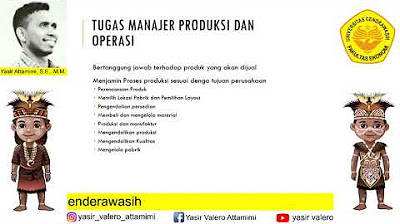What is the difference between production planning and scheduling?
Summary
TLDRThis script distinguishes between production planning and scheduling, highlighting their roles in manufacturing. Planning is a high-level overview that balances resources and demand over a 6-month to 3-year horizon, focusing on quantities, inventory, and investments. Scheduling, on the other hand, is more detailed, concentrating on the production of individual items or SKUs within a shorter time frame, often up to a year. It involves assigning specific tasks to workers and machines, synchronizing resources, and ensuring timely delivery to meet customer needs. Both processes are crucial for efficient production and are closely linked, with planning setting the stage for detailed scheduling.
Takeaways
- 🔍 Production planning and scheduling are closely related but distinct processes in manufacturing.
- 🏭 Production planning is a strategic, high-level process that involves balancing resources and demand over a longer time horizon (6 months to 3 years).
- 📈 Planning requires inputs like Bill of Materials, stock availability, resource costs, lot sizes, and manufacturing lead times.
- 🛠️ Scheduling is more detailed and operational, focusing on the short-term (1 month to 1 year) and assigning specific tasks to resources.
- ⏱️ The time buckets for planning are weeks or months, while scheduling can be as detailed as hours or minutes.
- 👨💼 Top management is typically involved in planning, whereas scheduling involves middle management and shop-floor execution.
- 🔄 Both planning and scheduling are iterative processes that inform and are informed by actual production outcomes.
- 📊 The goal of scheduling is to create a detailed calendar of operations, assigning resources and workers to meet customer needs.
- 📋 Production planning and scheduling are essential for efficient resource utilization and meeting production targets.
- 🔗 The two processes are complementary, with planning setting the stage for scheduling, which in turn enables effective production control.
Q & A
What is the primary difference between production planning and scheduling?
-Production planning involves the whole manufacturing process on a high level to produce finished goods, balancing resources and demand, while production scheduling is more detailed, defining the production quantities of single finished products or SKUs, assigning specific resources and workers, and planning detailed steps.
What resources are typically needed for both production planning and scheduling?
-The resources needed include Material, People, Machinery and equipment, Energy, and Management. Management is considered the 'software' of the company, defining how to convert raw materials into final products efficiently.
How does production planning balance resources and demand?
-Production planning balances resources and demand by determining quantities to produce per family of products, desired inventory levels, resources to use per period, and investments necessary to match capacity and volume with demand.
What is the time horizon for production planning?
-The time horizon for production planning is typically from 6 months to 3 years, involving top management and looking at planning buckets by weeks or months.
Can you provide an example to illustrate the concept of a Bill of Materials (BOM)?
-A Bill of Materials is a broken-down list of components and subcomponents needed to make the final product. For instance, in baking a cake, the BOM would include all the ingredients required, such as flour, sugar, eggs, etc.
How does production scheduling differ in terms of time horizon and detail compared to planning?
-Production scheduling has a shorter time horizon, typically between one month and one year, and a higher level of detail. It focuses on defining the production quantities of individual finished products or SKUs, assigning specific resources and workers, and planning all detailed steps.
What are the planning buckets in production scheduling?
-In production scheduling, planning buckets can be as short as hours or minutes, allowing for a more granular control over the production process and resource allocation.
Why is it important to consider the availability of items in stock when planning production?
-Considering the availability of items in stock is crucial for activating purchasing when necessary or utilizing existing stock, which helps in managing inventory levels and preventing stock-outs or excess inventory.
How does production scheduling help in bridging the gap between planning and actual production?
-Production scheduling acts as a bridge by scheduling every single operation at a specific time, assigning resources and workers, and planning detailed steps. It ensures that necessary resources are available at the right time, thus facilitating smooth production.
What is the role of management in the production planning and scheduling process?
-Management plays a pivotal role by defining how to combine the first four elements (material, people, machinery, and energy) efficiently. It is responsible for the strategic direction and execution of activities, ensuring that the production process is aligned with company goals.
How does production planning and scheduling contribute to efficient resource utilization?
-Both production planning and scheduling contribute to efficient resource utilization by ensuring that limiting resources are combined in the most effective way to produce final products. Planning determines when to make products, while scheduling focuses on how to make them happen in detail.
Outlines

This section is available to paid users only. Please upgrade to access this part.
Upgrade NowMindmap

This section is available to paid users only. Please upgrade to access this part.
Upgrade NowKeywords

This section is available to paid users only. Please upgrade to access this part.
Upgrade NowHighlights

This section is available to paid users only. Please upgrade to access this part.
Upgrade NowTranscripts

This section is available to paid users only. Please upgrade to access this part.
Upgrade NowBrowse More Related Video

Materi kuliah Pengantar Bisnis, Pertemuan Ke-5

Campaign Planning in ePPDS| Consulting Notes| Training for beginners|

Staff PPIC, Apa Jobdesk nya, Aktivitas nya & Skill yang dibutuhkan

Aquatic Biomes | Biology

What is the Material Requirement planning (MRP)? | MRP Process

Production Systems - Facilities & Manufacturing Support Systems
5.0 / 5 (0 votes)